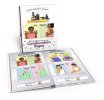Teaching Babies Sign Language
You begin with simple words and expand the word list as skills grow. You will begin teaching your baby how to sign before he or she can talk or even sign properly – usually between six and nine months. It takes hand coordination skills to sign gestures.
When you begin teaching babies sign language, you should have complete attention from your baby. You can start with words for things that are commonly done or used involving the baby. These will be words like “eat” and “toy” and “milk” and “book”. Start with a few signs and try not to teach too much too soon.
Some parents start with only the need based words such as “eat” or "drink". Other parents try to use words that generate baby excitement and interest like “dog”, “cat”, “bird”, etc - if your infant enjoys animals. You as the parent know your child best and can decide the best route to teaching Baby Sign Language.
When teaching babies sign language, try to use the sign every chance you get. When reaching for a book, reading a book, or putting a book away, sign for the word “book”. Hold the book in front of your baby making sure the she or he is looking first at the book and then your hand gesture. You are trying to get your child to not only make the sign but also connect the sign to the object.
When your infant begins signing, you can begin to add commonly used words. After Baby has the basics down (such as “eat”, “more”, “milk”, “all done”, etc.) you can then start signing the words “Mommy” and “Daddy” and “apple” (or other favorite snacks/foods). You can also begin to add words that express emotions such as “pain” and “wet” and “love”. The same ‘rules’ apply. When signing for “love”, say “I love you” out loud and give Baby a hug!
Repetition is the key to success when teaching babies sign language. It takes patience to teach infant sign language.
You will want to make the sign over and over again without knowing when your infant will respond. It may take a couple of weeks, but it could just as likely take a couple of months. Please remember to be patient. It will happen!If you set unreasonable goals for your infant, it can leave you feeling a little discouraged.
Remember, your little one is just a baby and will learn at an infant pace. By making signing part of the daily routine - one day soon your infant will respond with a gesture in Baby Sign Language.
When your baby makes the first infant sign language gesture, the gesture may not look like yours. It will probably look uncoordinated at first and hard to recognize as a hand sign. This means you must try and pay close attention to your infant’s hand movements in the beginning in order to recognize attempts to use Baby Sign Language.
You may continue to build the signing vocabulary as your baby grows older. Some babies develop as much as a forty to sixty word signing vocabulary by or before the time they begin to talk. Imagine that! Teach your babies as much as you can; and as much as Baby can and wants learn. As your infant learns, you will be able to add more words and even simple sentences. There is no such thing as “too much baby signing”.
Please utilize the many free online sign language resources available for learning the art of teaching babies sign language. The resources include online signing dictionaries and suggestions for ways to make Baby Sign instruction fun for your infant.
Please also see
“How to Use Sign Language With Your Baby”
for other ideas.
And lots of great information on:
How do I learn baby sign language?
Sign Language Related Activities to Share with Baby
British Sign Language for UK Babies!
Testimonials from Baby Signers
Teaching Toddlers Sign
See the proof - Babies Signing on Video!
Return from "Teaching Baby Signs" to "Babies and Sign Language" start page
















